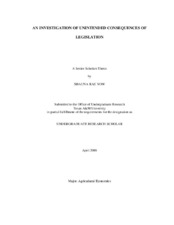| dc.description.abstract | Texas is experiencing dramatic population growth with an expected doubling by 2050. This growth suggests a substantial increase in the demand for potable water when the state already faces serious water issues. Such dynamics raise concerns regarding both the quantity and quality of future water supplies. One area in which alternative water sources and potable treatment methods are being sought to support a rapid population growth is the Texas Lower Rio Grande Valley. In addition to Rio Grande surface water conventional treatment plants, an emerging and promising approach to expanding potable water supplies is brackish groundwater desalination. Based on recent technology developments in desalination membranes and increasing prices of surface water rights, economics of desalination have become more competitive with traditional treatment methods.
This relationship between conventional and desalination treatments was impacted by 2007 Texas legislation through an amendment to Senate Bill 3 (SB 3). This amendment to SB 3 was an attempt to facilitate meeting increased demand for municipal water and as such, established the price at which irrigation water in the Lower Rio Grande Valley can convert to municipal water, as a result of urban/residential development of agricultural land, at 68 percent of the market price, effective January 1, 2008. Preliminary economic and financial investigations suggest this legislation could introduce an economic bias in the choice between traditional treatment and emerging desalination methods. The institutionally-driven lowering of the costs of conventional treatment methods relative to desalination methods is an example of how legislation can unintentionally impact local decisions and technology adoption. In this case, studies indicate that desalination was less costly, but with the legislation-driven reduction in surface water, conventional treatment becomes the less expensive choice.
The consideration of economic theory and implementation of economic and financial analyses are useful in evaluating the magnitude of possible economic impacts introduced by legislation that impacts this region’s water market. Such effects can negatively impact the adoption of emerging alternative technologies for producing potable water. In addition, unexpected impacts of legislative actions can be identified. The overall objective of this work is to identify the most efficient method and source of providing water to regions where water is scarce and population is rapidly increasing. | en |


